1. The imagined nation inside a box
While I was living in Indonesia, I started composing my own shadow box. A shadow box is a case containing various objects, grouped according to a theme of personal significance. I don’t really know why I started it, it definitely wasn’t for artistic purposes or worse, academic interest. I was just accumulating objects that were too cheap to be brought back to Italy but too interesting to be left around. It contained simple things like a small flag of Indonesia, a fake gold reproduction of a tiger, a picture of a dancer, a 10,000 rupiah bill showing the first president Sukarno and vice Mohammad Hatta, and so on.
At the time I understood that I was building my own intimate Indonesian museum, gathering and selecting all the objects that would (at least for me) be appropriate representatives of the nation I was doing research in. It was my imaginary picture of Indonesia through cheap, meaningless objects.
Indonesia is a peculiar case of “imaginary land”; it is indeed peculiar because of its concrete existence. In fact, we usually deem imaginary lands as nonexistent places, results of pure speculative fiction and of somewhat reverse taxonomy. We let singular features and elements form the unit as a whole, building a coherent picture from scattered fragments, in which the coherence itself cannot be anything but imaginary.
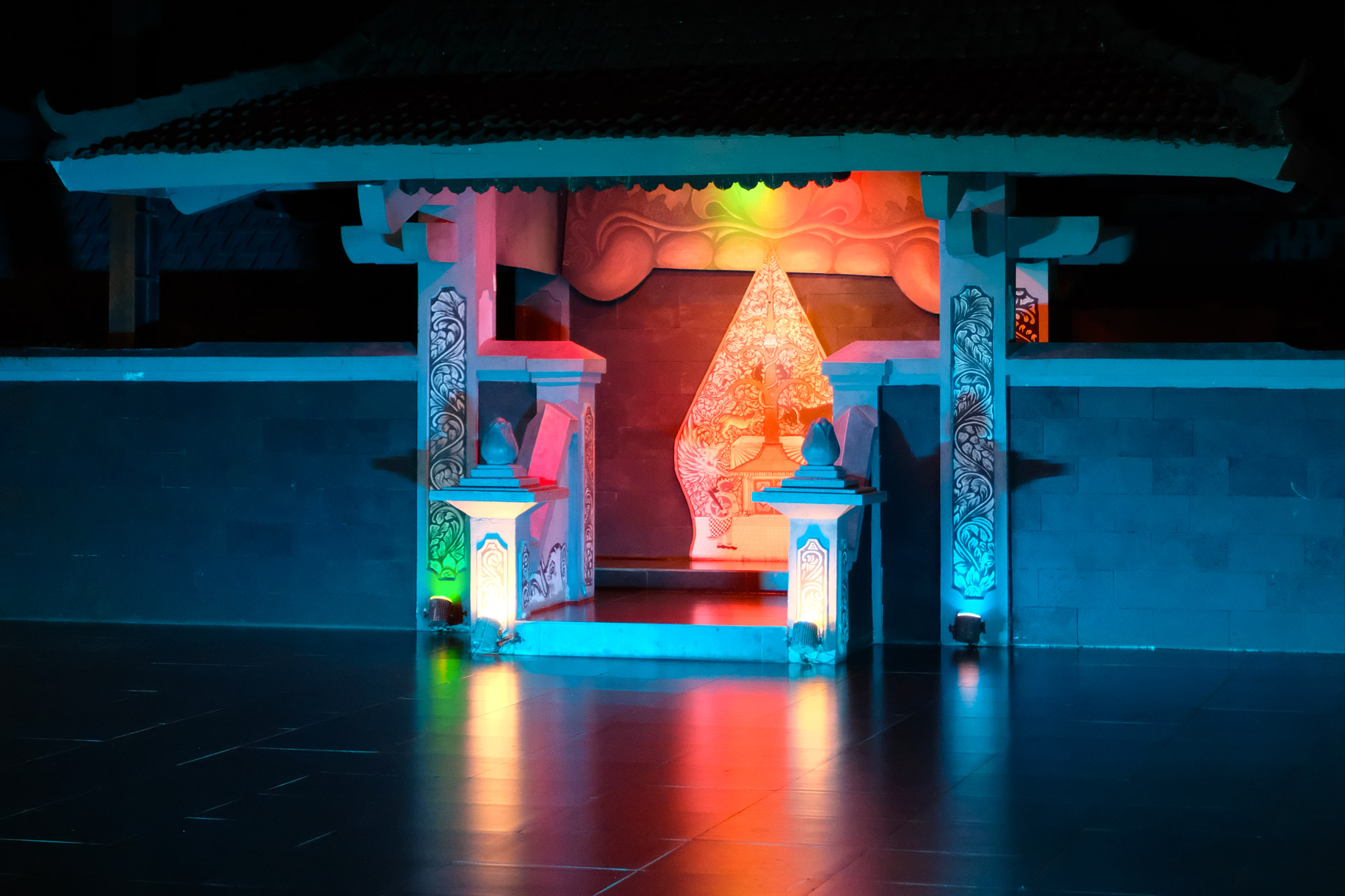
Although this is all extremely correct in the common sense, the use of the term imaginary as a synonym for nonexistent is not completely accurate. In fact, we use our imaginative faculty continuously, structuring present and missing information to build pictures of things and concepts in conscious ways, obtaining what we usually call an imagery and acting upon it as if it were real. From this perspective, we can begin to understand that the line we use to divide fiction from reality, can, at times, be a pretty sneaky instrument.
Our imageries continuously act on us as much as we act on them: a system and vehicle of stimuli, preconceptions, expectations, messages, and commands to which we relate. So, what’s the point here? Are we all acting upon fake premises and self-indulgent lies? Is our reality virtually unreal? I must admit that these questions may sound captious and futile, the same boring scientific fiction theme and millennial speculative philosophy that has been explored since the sixties. Is this all a riddle for stupids?
I was personally never interested in these kind of mental experiments, even though it may seem strange to acknowledge it, this conjectural structure of virtuality has more than something in common with the way we develop our intimate take on The Exotic. The International Encyclopedia of Social Sciences dubs Exoticism as:
[...] a cultural phenomenon that projects Western fantasies about profound cultural differences. It adopts a cultural perspective that is firmly entrenched in the conventions and belief systems of Western civilization and therefore constructs the East as the archetypical location of otherness.
In this respect, Exoticism is the way the Northern-Atlantic mindset projects its own virtualities and imageries towards far-flung lands and nations of the East. Indonesia, alongside Thailand and India, exist in people’s minds as completely fictional lands of magic, nature, spirituality and mystery. According to Edward Said, colonial imperialism is the outcome of a certain knowledge and power, where power and knowledge are perversely interchangeable. The faculty of imagining a land ultimately tells what extent an individual has control over it. Indonesia, the imagined nation.
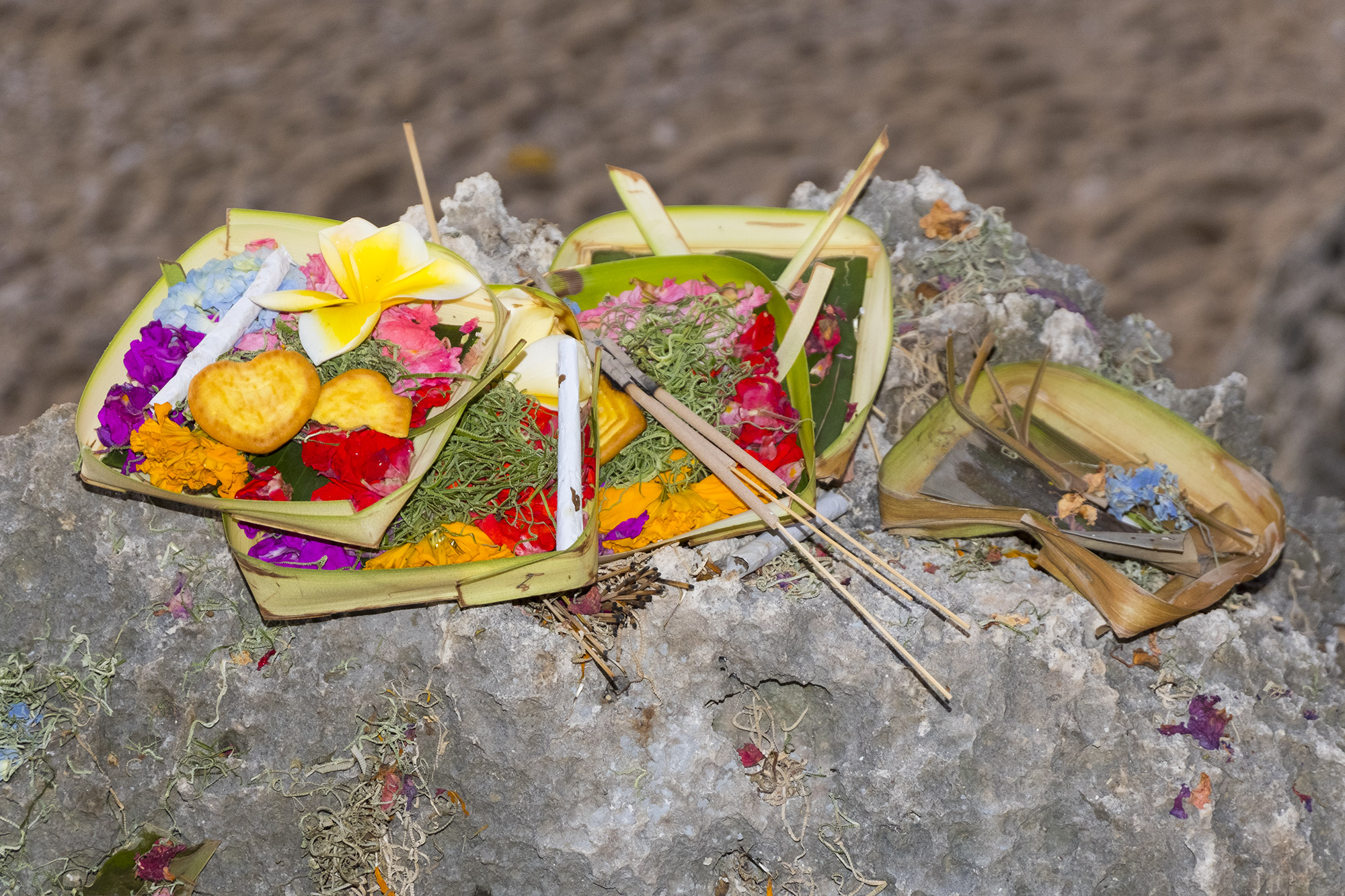
In Harry Harotoonian’s exegesis of Victor Segalen’s Essay on the Exotic, exoticism would be nothing more than the best suited candidate:
to protect contemporary life from the relentless banality wrought by the transformation of capitalism into mass-society, imperialism and colonialism.
[...] This exoticism followed the itinerary of capitalism as it migrated around the globe and often masked the violent seizure and colonial expropriation that was at the heart of its law of movement. Segalen had observed that this exoticist practice was based on the prospect of an elsewhere, driven by the novelty of geographic unfamiliarity but exemplified by intrepid travelers/tourists like Pierre Loti, the explorer Richard Burton, and the cultural misfit Lafcadio Hearn. It signified the primacy of the spatial dimension of capitalist expansion at the expense of its temporal workings and thus managed to displace and often efface the baneful effects of the actual deterritorialization and reterritorialization of land, labor, and capital that transformed and destroyed received cultures of reference to make them little more than outposts of Western civilization.
[...] This mode of exoticism was entirely committed to spatializing territories into fixed, static, and unchanging landscapes that existed in temporalities outside of modernity: vast, ethnographic museums of alien cultures and peoples who lived in a zone of contemporary noncontemporaneousness that would soon disappear before the homogenizing machine of industrial capitalism.
The fallacies of these theories lie in the fact that millennial capitalism, as a natural prosecution of colonial imperialism, is not something moving as a liquid and expanding from the center to its periphery. On the contrary, neoliberal capitalism is something way more complex, facing, such as the exchange between imagination and imagined, a mutual relationship between center and periphery.1
It may be true that we as inhabitants of the North-Atlantic have exoticized visions of tropical places, but how much of this vision was built by those nations themselves? How has the interaction between the two equally exotic visions influenced the West and the East alike? In this process, concluding that exoticist paradigms were only invented by Westerners, would only be an inaccuracy: part of the same paternalistic idea that only the West can craft and adopt concepts.
When Indonesia gained independence from the Dutch in 1945, at the end of WWII, president Sukarno and, after him, president Suharto had to bring together under a single flag, 300 ethnic groups, 700 local languages and 2 million square kilometers of territories divided into 1700 islands. They had to come up with a strategy to separate what is now called Indonesia from the former Malay Archipelago, which developed Indonesian culture from scratch and thus built a live cultural museum.
In fact, Sukarno’s strategy was structured in two phases: selecting art forms that could provide a better idea of a nation deeply rooted in tradition but, at the same time, directed towards progress. This caused the beginning of a long and not yet concluded phase in which Indonesian arts started losing or, better, reworking their ritual and spiritual values, while opening new paths towards performance display and contexts. The second phase was based on trying to separate Indonesia from the first world as much as possible, breaking diplomatic relationships with the West and spurring the new Indonesian population to create more indigenous art forms that could rival the Western ones2. The high-handed presence of Gamelan music in global imagination, despite other genres, is partly a consequence of these politics.
We can see that “live cultural museum” is not, or at least not only, an expression. The idea being that Indonesia’s first government wanted to stress that culture had to be on display as a mean to gain power and concreteness at the eyes of the world. This is particularly true if we think about how Clifford Geertz already pointed out how Indonesia, as a nation, has more to do with theatre than politics; a theatre state3. Indonesia had just made up its own shadow box.
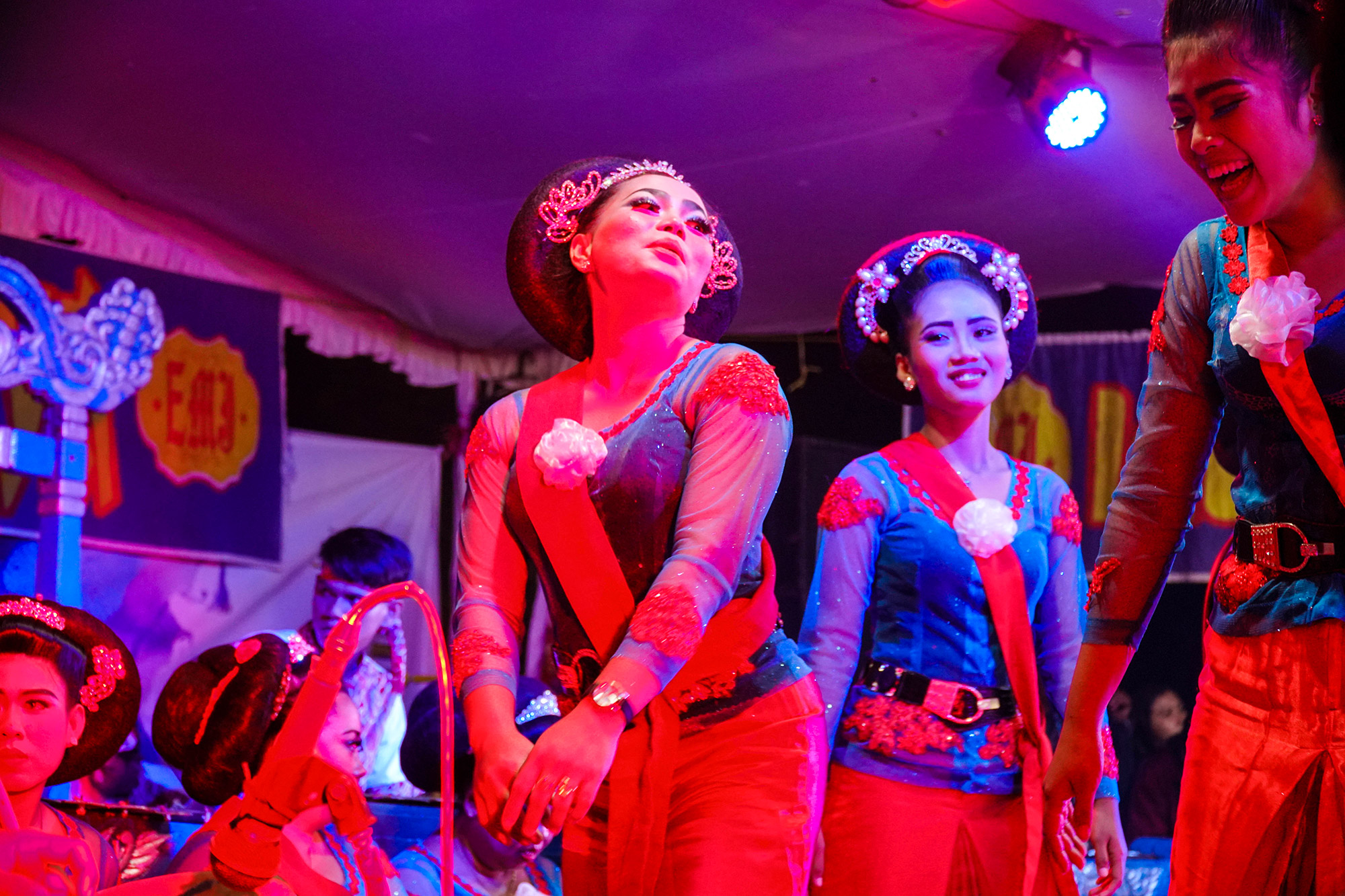
In general it is hard to notice, once something is stored behind glass, in a theca, the reason why it was put there; the initial theme given by the organizer gets lost and the whole figure and history of that object presents itself at the eye of the beholder, both out of their original contexts. In this case, art forms are usually stuck inside their own nation because of a not favorable economic situation and impossible policies concerning immigration and visas, while managed according to a liberal and pushing tourism and culture policy. Behind the surface of things, there is a disposable stratus of histories, politics, economies, and symbols (both secular and sacred).
The “objects” in our shadow box show a relation that goes beyond the conscious and voluntary links that those who organized them – in this case Indonesian cultural policies – wanted to show. Every element tells a story and each story relates to the other elements. In this text I won’t have the space or time to go deep inside each of the elements I will point out: this experiment wants to show how cultural phenomena based on art and performance can be conceived as live shadow boxes, organized by institutions and communities, social hierarchies, and symbolic structures.
2. Dancers, gangsters, sound systems and the power of drums
When people say Indonesia, they usually mean Bali. They know Jakarta exists and they probably know that last year a certain number of different calamities, such as the earthquakes in Lombok, the Tsunami in Palu and between Sumatra and West Java very recently – have hit the Archipelago, causing thousands of deaths.
During my field work in Jawa Barat, West Java (Jabar from now on) I fell in love with Jaipong Bajidoran, a very popular working class musical style native of Jabar. The style combines many autochthonous genres, such as Ketuk Tilu, Jaipong, Kliningan, Gamelan Salendro (played on a pentatonic scale), and Disco. Born around the end of the sixties in Karawang and Subang, during the time when Indonesian artists were pushed to abandon Western music and focus on creating new “native art”, it is part of what is often called tradisi kontemporer, or contemporary tradition4. While very famous in Java, it was never recognized worldwide because of its excess and kasar (rude) nature.
To dig further into the alleged raw nature of the style, the word “Bajidoran” appears to come from the folk etymology (kirata) Ba-ji-dor, which can be explained as BArisan JIwa DURhaka (row of rebels) or BAJIngan DORaka (sinful bad guys), indicating the on-the-loose and often chaotic attitude of the Bajidoran participants.
Altogether, Bajidoran ensembles can create an atmosphere of liberatory raving, seldom seen in music; the Sundanese believe traditional folklore is pushed to its very limits and fully contaminated by the local contemporary dance party culture. Bursting and blasting polyrhythmic drum beats with adjustable pitch, such as African talking drums, fill every centimeter of the stage, dragging people to the pit to dance for up to five hours, as if they were entranced. A mix of erotic and humorous jokes and innuendos diffuse, cracking and croaking from the broken cones of the sound systems, darkened and sharp. I was fascinated.
After participating and following Bandung’s Bajidoran scene for a while, I was offered the opportunity to go to Karawang to watch and record Namin Group live in their hometown. Namin Group is, if not the first, one of the first Bajidoran groups ever, also being the most commonly known. Since the sixties, Namin Group is part of Jabar’s latest developments in terms of contemporary tradition, having actively collaborated with many known artists, such as Ismet Ruchimat of SambaSunda5.
So, I took the bus from Bandung to Karawang, to attend the show. The weather was hot and humid. After a three-hour journey, I started asking around and eventually met with a young guy, who said he knew Namin group. He offered to host me for the night and brought me to the show. After half an hour we were at the venue, in front of the stage. I greeted all the members of the group. Everyone was ready. I had my own private Indonesian shadow box.
The groups are composed by a variable ensemble of approximately thirty members with different roles such as technicians, dancers and musicians. The music section is composed by two medium saron or saron barung, a big saron or saron demung, bonang or section of small kettle gongs, selentren, goong, up to four kecrek (a stack of iron plates hit with a wooden hammer that may be obtained from random pieces of iron or more commonly from motorbike brakes), two kendang, kentrung (a set of additional kulanter played with a stick), rebab (bowed string instrument), gambang (a xylophone-like wooden instrument), an MC and a sinden or juruh kawih (main singer).
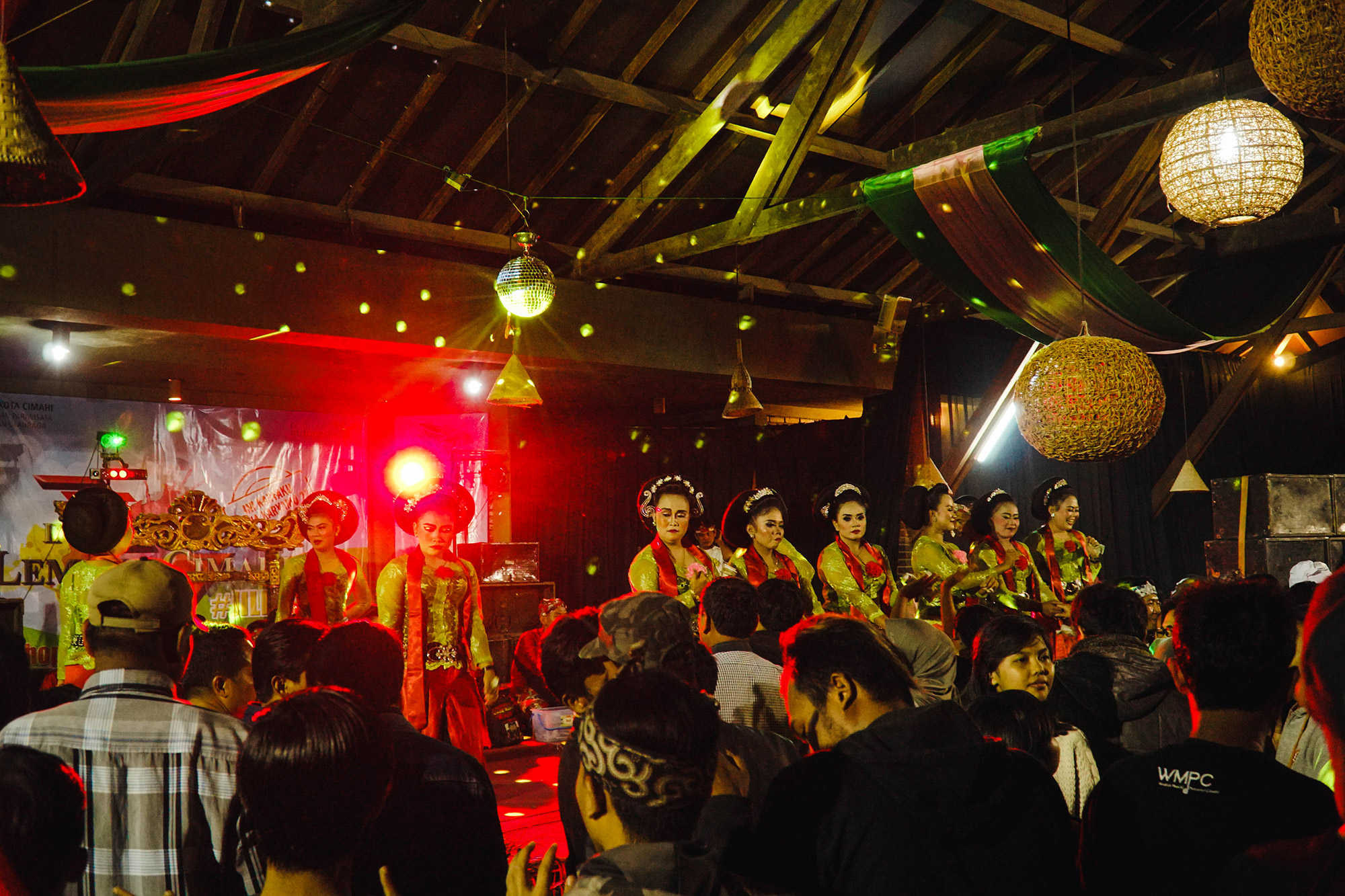
The coexistence of wooden and bronze instruments is interesting; in Indonesia, the material from which the instruments are made tells us a lot about the nature and social position of the music. If we think about the difference between bronze and wood instruments in terms of economical and physical difficulties of production and maintenance, it would be logical to think that Gamelan, in comparison to Gambang, is prerogative of aristocracy.
The presence of both in a popular and working class style such as Bajidoran tells us how Sundanese culture, which likely did not have any Gamelan music before being conquered by the kingdoms of Central Java, brought the instruments to a more democratic level6. This egalitarian tendency can also be found in the integration of songs from the pop sunda and dangdut7 repertoires to Bajidoran’s one, which originally featured only Sundanese traditional songs.
The ensemble is then amplified with cheap microphones that blast everything out of a huge sound system at killer volume. Both singer and MC have short reverberated delays on their channels, while the kendang’s microphones are usually modified, manipulating the internal capsule to gain a pointed piercing sound. In addition, it may be connected to a supplementary compression pedal.
Shortly after arriving, I noticed that alcohol was sold in the open air, which is unexpected considering that law, Muslim religion and customs all strictly forbid this. At parties you hide yourself, if you want to get drunk. You can seldom see a bottle handed by one person to another. It felt weird and uncomfortable. At the time, I did not know that Karawang is one of the biggest human trafficking centers of Indonesia and at the same time, one of the most industrialized areas of Java. I set the recorder, the microphones and started recording.
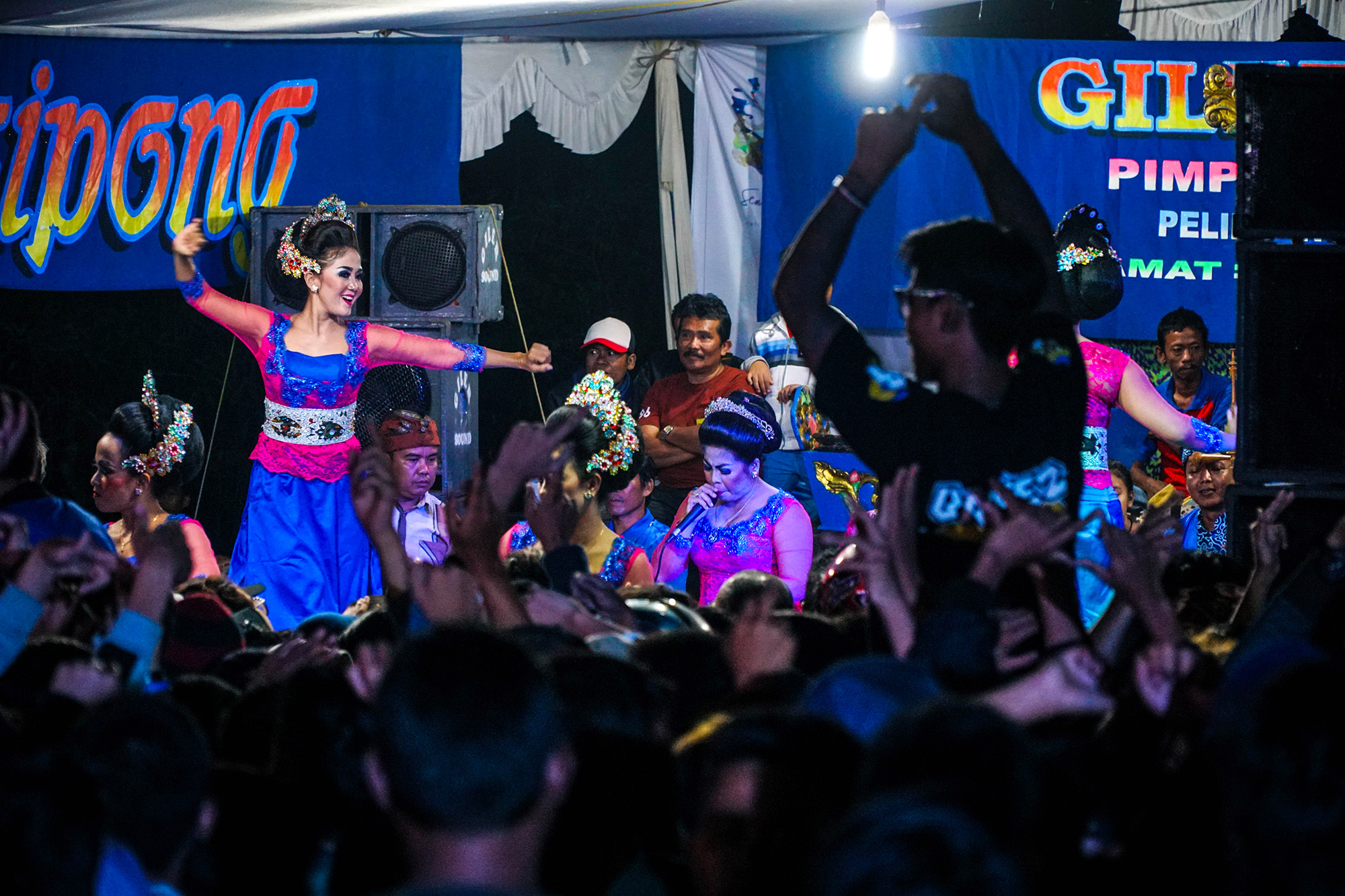
During the first part of each song, in a phase which is called mincid, a few men and some woman had to dance individually in front of the stage, after making a donation to the group. They were free-form dancing inspired by the national martial art pencak silat and illuminated by acid lights, following the rhythms of the kendang and trying to control it with their movements. At the climax of each combination of movement, the best dancer gets a still pose that expresses manliness, danger, elegance, and aesthetic beauty.
When the mincid is over, the sleepy, sweating audience stands up from their tables and get closer to the stage. The dancers start collecting donations from the top, while the men and women dance. We also spot a few Waria: a term used to popularly identify transgender and transvestites – Wanita (woman) and Pria (man) – which are mocked, but also kind of welcomed.
The erotic, humorous and excessive nature of the performance can be traced back to the symbology of gender, power and fertility among the Sundanese. In Sundanese music, the singer/dancer can be conceived as a symbolic equivalent of the mythological figure of the ronggeng: the female performer incarnating the energy of Nyi Pohaci, goddess of rice and fertility. The bond between performance and sex in Jabar stems from ritual; in the past, it wasn’t uncommon for men to have sex with the ronggeng, even with approval from their own wives. This was permitted in hope of fertile land, healthy progeny and thus, to gain the energy and the power of the goddess8.
These original ritual roles must be transposed into Sundanese contemporary party culture, where new and more secularized symbologies regarding manhood, power, gender roles and sex have influenced the show. In general, the figure and function of the ronggeng has split between the singers, dancers and the prostitutes, respectively; the finest representatives of male desire and its official operators, mediated by the commodification of art and the body.
The actual conceptions of power emanating from the music and the female performers partly lose their ceremonial nature to gain a more social value: while the intercourse with the new “Goddesses” is forbidden and condemned by the new national and religious laws, it continues to occupy an important place in male sexuality. Desire of fulfilment comes from “supernatural drives” and magic forces. On the social level, sex became a way to gain social power as a male figure: a legitimization of the male self.
The erotic drive towards the dancers, due to this correspondence, is partly satisfied in the physical contact and the moment of intimacy that the donations to the female performers offer, although it can never be fulfilled. For this reason, I think that the Waria function as catalyzers and relief valves for men’s erotic frustration: men, unable to touch and experience the performers, vent their need for physical contact on subjects who can be considered as symbolic substitutes for women and with whom improper and indecent interactions are allowed, always in the form of trivial jokes9.
Dancing is, in Sundanese culture, a very important part of sociality: it is a way to show appreciation for the situation to which one is invited or welcomed, a way to show one’s lack of shyness and courage, thus their ability to handle situations. In Bajidoran, dancers follow the idea of triping: a vernacular adaptation of the English word “tripping”, used to explain the sensation of dancing to this particular disco style, which some youngsters have dubbed the drum ‘n bass of Indonesian music10. The sensation is, in this way, compared to the effects of ecstasy; dancing without inhibitions and letting oneself be driven by the music in a state similar to transcendent dissociation. At once, on the dancefloor, all differences and antagonism between classes and groups are suspended.
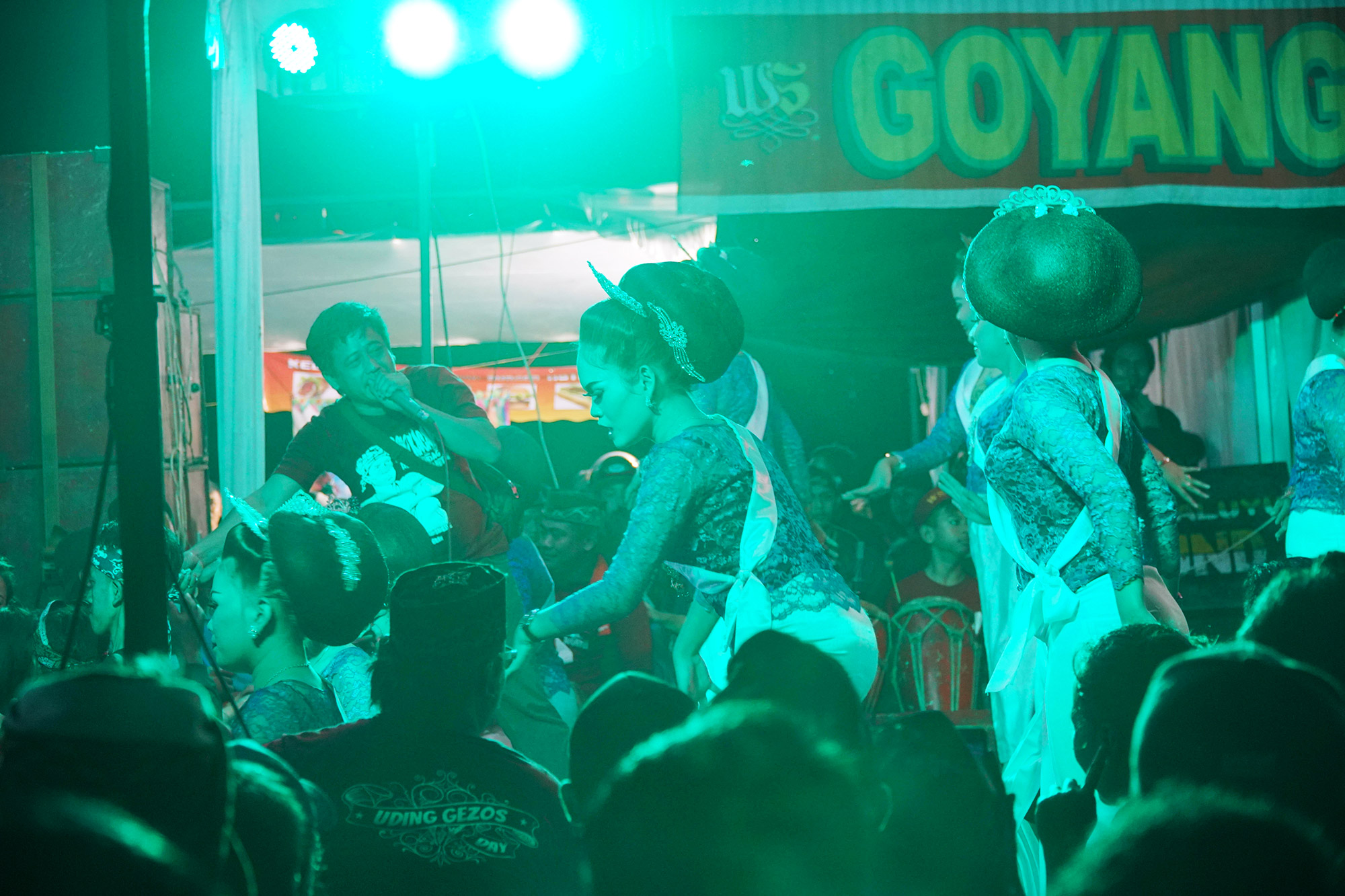
3. A nightmare in the jungle
After the show ended, I packed my stuff and hopped in my new friend’s car. While we were going home, my driver called someone on his phone, speaking in vernacular and incomprehensible Sundanese. He stopped in a dark, solitary road in the middle of nowhere. I noticed a white car a couple of kilometers from us, parked on the side of the road. My friend asked me to wait a couple of minutes and, after closing the door, walked fast to the other vehicle. I watched him step further away in the rearview mirror. From the passenger seat in the pitch-black SUV I could not see anything. Suddenly, everything was weird and eerie.
As soon as my host left the white vehicle, it disappeared into the night like a metallic animal in the shadows of the tropical jungle cast by the giant palms. Slowly, he walked back to the car and entered. He turned to me and, in dented English, told me: «This is off the record.» «What are you talking about?», I asked. «Saya beli narkoba. Saya beli Shaboo». Literally: «I bought drugs. I bought Shaboo.». He turned on the engine and we got swallowed again by the squirming shadows and the murmuring vegetation in between the villages, decorated by scattered plastic waste and abandoned cigarette butts, shiny and strange, when hit by the car’s headlights.
As soon as we got home, while my friend was changing his clothes and I was thinking of a way to escape this uncomfortable situation, I heard engine noises coming from the road in front of the house. Something totally unexpected and dreadful was about to happen.
The car entered the small, dirty lot near the house and parked. When the driver turned off the engine I could finally see that it was a police car. I started freaking out, but I knew I could not do anything and panic was not the right choice. I just kept calm and waited to see what was going to happen. They were two middle aged policemen in uniform. When they arrived and knocked, my unaware host opened the door. They greeted us with the warmest of sneers and the most piercing look and entered without being invited.
After some circumstance chitchat, which at that point just sounded surreal, the one who resembled the chief, asked my host to speak privately in his room. I felt a cold shiver crawling down my back and entering my body down the flesh around the spine, wet from the tropical heat. I was waiting for something terrible to happen, crouched on the floor, talking about which Indonesian food I like the most with the left policeman.
When they reappeared from the small room they were talking in, I finally discovered, with deep sadness, that they had come for the drugs. What I could not forecast was that they were going to smoke together all night long, passing hand to hand the dirty plastic bottle originally containing some cheap fizzy drink with a ridiculous name. After a while, the chief, standing, asked me if I wanted to smoke with them. After I had politely refused, he opened his mouth in a huge smile full of teeth. With penetrative, absent eyes, slowly flexing his arms while still holding the bottle in a Refn-like fashion, he said merasa kuat - It makes you feel strong.
Trembling with fear, I did not know what to do. I waited. When the dawn finally arrived and all three were sleeping, looking like a zombie I took my stuff and hitchhiked to the nearest bus station, where I returned to Bandung and forgot about all this. I never felt so off the beaten track and, still, it was something completely outside my idea of an exotic adventure. Under the frame, behind the objects, uncanny movements were animating the shadow box.
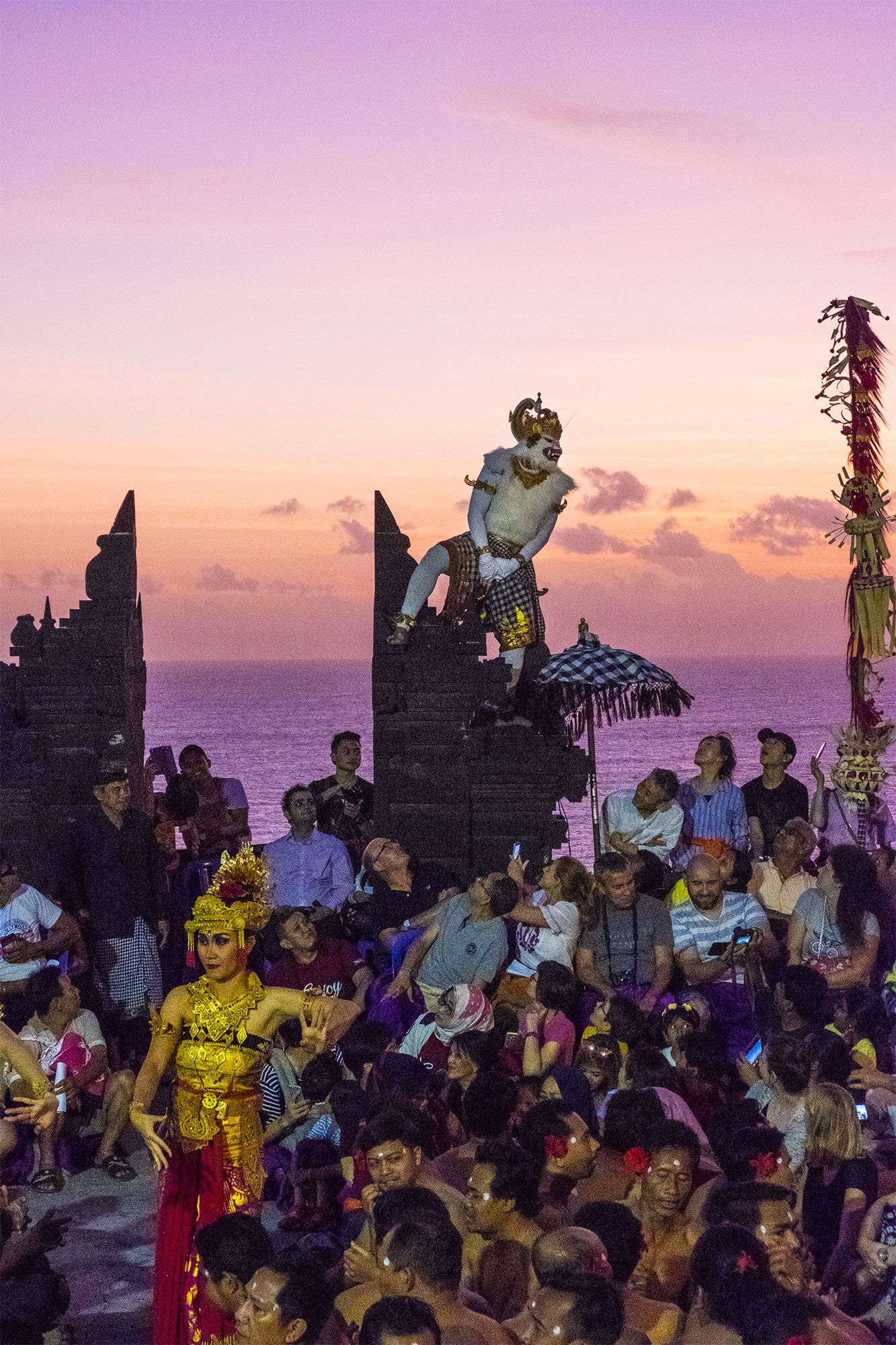
Bajidoran used to be a genre not worth of institutional attention, and for this reason it seems at least weird to use it as an example for our hypothesis. Cultural politics in Indonesia have always supported Javanese music in the first place, largely neglecting other areas of the Archipelago. Nowadays, thanks to the work of people such as Ismet Ruchimat, Abah Enjum and SambaSunda, Tarawangsawelas, Karinding Attack, Jasad, Budi Dalton and Ensemble Tikoro, Sundanese music is getting new attention both nationally and internationally. Bajidoran ensembles start to be invited at institutional events and celebrations. For this reason, I can see a certain level of ennobling of the style on behalf of the institutions.
The Indonesian government is trying to give the impression that Bajidoran, similarly to Réak, Jathilan and other cultural phenomena, is one of the noble performative arts of pleasant harmless aesthetic beauty, using decontextualization and recontextualization as an instrument. We must always think that, even if by means of native perspective and perceptions, arts are manipulated, although way more in the past than now, to be convincing to both Indonesia and to the international community. This way, both Indonesia and the North-Atlantic communities are collaborating to create a common exotic view of Indonesian arts.
As an answer to the popularization of crude Indonesian phenomena, such as Bajidoran, institutions are trying to emendate them to obtain presentable products. At the same time, to the careful eye, any element of a Bajidoran performance tells a different story, or better, a bunch of different stories about controversies, struggles, colliding paradigms and social values. Indonesia’s economic, political and cultural history and their interplay with the rest of the world and, in particular, with the first world shed a different and darker light upon Indonesian music. It simultaneously gives a layer of genuine realism, telling stories about Goddesses and prostitutes, rituals and exploitation, ancient kingdoms and sound systems.

